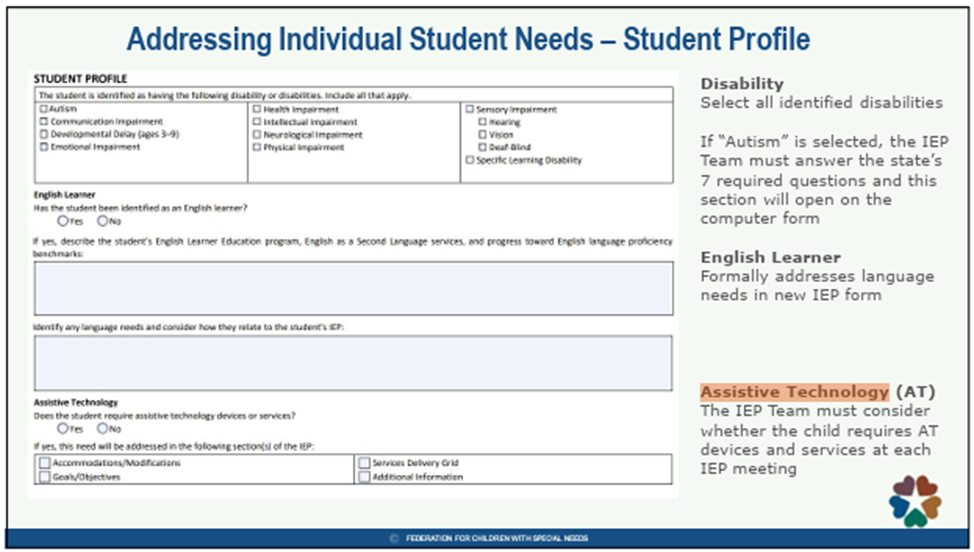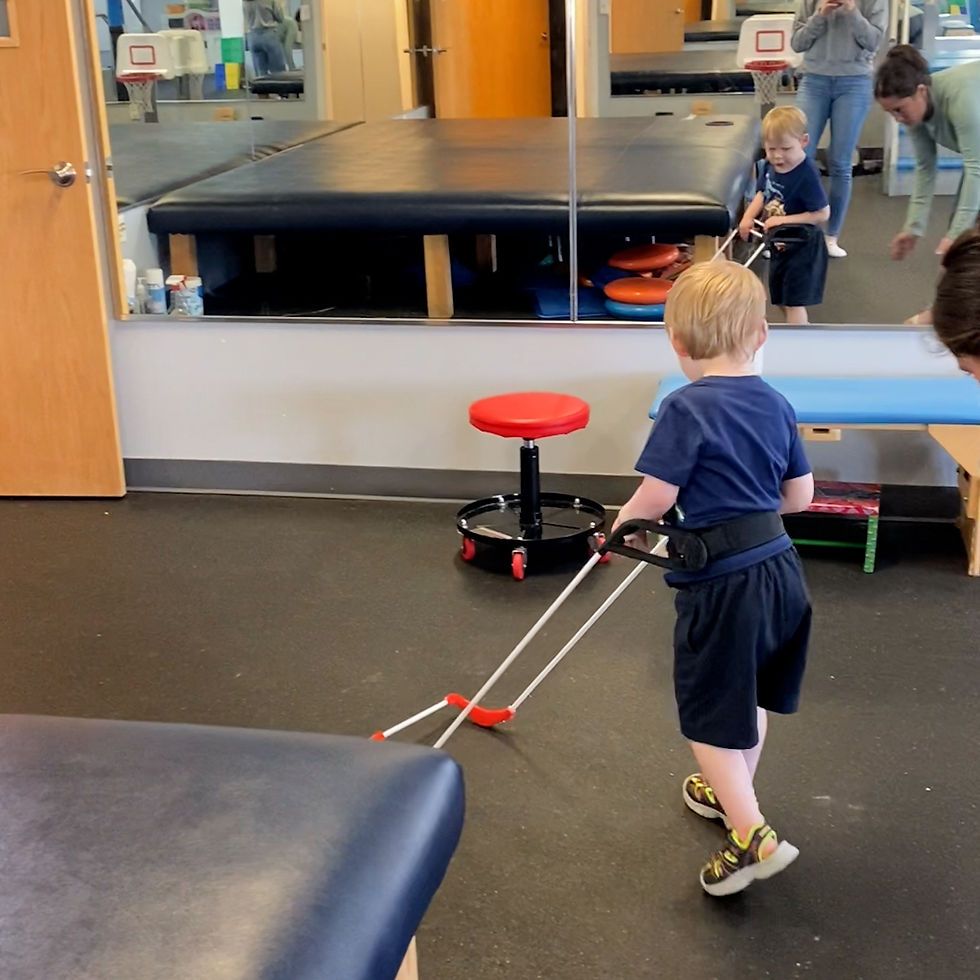How to Get a Pediatric Belt Cane Included in a Child’s IEP Under IDEA
- Grace Ambrose-Zaken

- Oct 14
- 9 min read
Updated: Oct 20

Assistive Technology (AT) The IEP Team must consider whether the child requires AT devices and services at each IEP meeting
When a child with a mobility visual impairment or blindness (this includes children who have IEP classifications that also include a visual impairment, e.g., multiple impairments) needs to learn safe ambulation using an assistive device for mobility, the Pediatric Belt Cane is an effective choice for many children. This blog discusses how to follow the steps outlined in the Individuals with Disabilities Education Act (IDEA) to include the Pediatric Belt Cane on a child’s Individualized Education Program (IEP) as a mandated assistive technology device.
IDEA 300.5 Assistive technology device.
"Assistive technology device means any item, piece of equipment, or product system, whether acquired commercially off the shelf, modified, or customized, that is used to increase, maintain, or improve the functional capabilities of a child with a disability. The term does not include a medical device that is surgically implanted, or the replacement of such device."

300.6 Assistive technology service.
Assistive technology service means any service that directly assists a child with a disability in the selection, acquisition, or use of an assistive technology device. The term includes—
(a) The evaluation of the needs of a child with a disability, including a functional evaluation of the child in the child’s customary environment;
(b) Purchasing, leasing, or otherwise providing for the acquisition of assistive technology devices by children with disabilities;
(c) Selecting, designing, fitting, customizing, adapting, applying, maintaining, repairing, or replacing assistive technology devices;
(d) Coordinating and using other therapies, interventions, or services with assistive technology devices, such as those associated with existing education and rehabilitation plans and programs;
(e) Training or technical assistance for a child with a disability or, if appropriate, that child’s family; and
(f) Training or technical assistance for professionals (including individuals providing education or rehabilitation services), employers, or other individuals who provide services to, employ, or are otherwise substantially involved in the major life functions of that child.
IDEA states that schools must consider and, where necessary, provide assistive technology devices and services at every IEP meeting.
In this IDEA roadmap we are seeking to help advocate using the guidelines available to everybody. Please reach out if you have any questions. The first stop is understanding what IDEA says about AT for children with disabilities whose educational services are legally mandated by an IEP.
1. Understand the Legal Foundation: IDEA & Assistive Technology
What IDEA Requires
The “special factors” section of IDEA requires that the IEP team explicitly consider assistive technology during IEP development.
Under IDEA, when an IEP is developed, reviewed, or revised, the IEP team must consider whether the child requires assistive technology (AT) devices or services to receive a Free Appropriate Public Education (FAPE).
The law also treats AT as potentially a related service, a supplementary aid or service, or part of the special education services — depending on the child’s needs
Cost, lack of teacher training, or school resource constraints cannot be used as reasons to deny a needed AT device if the IEP team agrees it is required.
Cost, lack of teacher training, or school resource constraints cannot be used as reasons to deny a needed AT device if the IEP team agrees it is required.
Under IDEA, the Pediatric Belt Cane meets the definition an assistive technology device. When requested in writing, schools must initiate and complete the formal IEP evaluation process to determine whether to mandate this assistive technology device and include assistive technology support and related services on the IEP.
2. Request A Mobility Device Assistive Technology Evaluation
Submit a written request to the IEP Team or a school administrator requesting an evaluation for a mobility assistive technology evaluation or orientation and mobility evaluation to specifically assess whether a wearable belt cane, e.g., the Pediatric Belt Cane, will increase, maintain, or improve your child’s functional mobility capabilities. (Need to take real care not to mention a specific product name during the IEP Process. If mandated, the district has to source product. In this case there is only one and we have provided a sole source letter on the website.)
This can be a short simple letter. “Dear IEP Team Leader (Name), I am writing to request an IEP driven O&M evaluation to assess whether a wearable belt cane should be added to my child’s (name) IEP as an assistive technology device.
In your request you can specify that the evaluation be conducted by a qualified provider who is credentialed to evaluate the mobility needs of a child with a visual impairment.
The letter of request allows the school to implement the next step, which is to convene the IEP team. If the child already has an IEP in place, a meeting will be scheduled to consider your request, or if an annual or three year IEP review meeting is already scheduled, this request can be considered at the already scheduled meeting. If this is an initial IEP meeting the team will address your request at this meeting.
Keep in mind there are compliance timeframes that determine when the evaluation has to be conducted and completed under state or Federal regulations. Be sure to find out from your IEP team about the compliance deadlines that your school district follows.
If the IEP team declines to evaluate your child after considering your request, or if the school conducts the evaluation and you believe the school’s evaluation is insufficient, you can request an independent evaluation (at district expense, under certain conditions) to document your child’s needs.
3. What Goes Into The Mobility Device Assistive Technology Evaluation
The assistive technology evaluation for a wearable cane belt cane documents the child’s present level of performance and reports:
how your child ambulates during daily mobility routines, e.g., with a mobility device such as a kiddie cane or AMD, with full physical assistance, or with a combination of a device and physical assistance
observed mobility and safety deficits, e.g., falls, trips, collisions, orientation errors
extent of your child’s age-appropriate independence with current means of ambulation in daily environments at home, in school, and in the community
times when your child avoids certain routes or mobility tasks
instances where you or your child limit exploration for safety reasons.
4. Gather and Submit Expert Recommendations & Reports
Seek endorsement(s) from a certified orientation & mobility (O&M) specialist. Their professional judgment can carry weight in the IEP meeting. Have your endorsing experts submit written observations/recommendations to the IEP Team or to invite the expert to attend your child’s IEP meeting in person or remotely. You must notify the IEP Team when you invite experts to attend your child’s IEP meeting.
If possible, work with your endorsing expert to arrange a demonstration of your child’s mobility with and without the wearable mobility belt cane in daily settings to share with the IEP Team, e.g., school hallways, playgrounds, and community sidewalks.
Video tape the demonstration. From the video record data about your child’s performed with and without the wearable belt cane.
Record falls, trips, collisions, orientation errors, the number of routes your child travels, hesitation time along routes, and whether or not your child was able to complete a route. Use this data to show how the device improves performance.
5. Relate Wearable Mobility Pediatric Belt Cane to Your Child’s Educational Needs and Progress
When it is your time to address the team during the IEP meeting talk about how safe mobility using a wearable belt cane supports your child’s educational needs and progress by building safety and independence for school mobility, e. g., accessing classroom spaces and activities, making age-appropriate transitions between school activities, playing with peers in the classroom and on the playground, exploring relevant environments, etc.
Come to the IEP meeting prepared to tell a compelling story about your child’s mobility and how the wearable belt cane has affected mobility and safety.
6. Prepare for The IEP meeting - The IEP Team leader is responsible for preparing and presenting the meeting agenda. Parents are welcome to provide input to the team leader during the process of preparing the IEP and setting the IEP agenda. Also, Parents are welcome to provide input at their child's IEP meeting.
Input items include providing any helpful notes they have, e.g., agenda items to include, AT evaluation information, proposed AT and related service goals and supports, and notes about school staff and family training.
Whenever an item(s) is not found on the Team Leader's agenda, Parents can request to add those items to the Team Leader’s IEP meeting agenda.
Parent notes can include any/all of the following:
Concerns about the child’s current mobility performance and safety challenges at home, at school, and in the community.
AT evaluation and expert report recommendations.
A short phone video demonstrating the child’s performance before and while using a wearable belt cane.
AT and O&M goal areas parents would like to include.
How progress toward goal attainment can be measured and reported.
Ways to integrate the wearable belt cane throughout the school day.
Ideas for parent and school staff training.
7. Ensure Correct and Effective IEP Language

A. The Assistive Technology Section. In the Assistive Technology Section list the device, as a “correctly fitted wearable belt cane”.
B. Supplementary Aids / Services / Accommodations, specify how and where the device will be used (e.g. most of the school day: classroom, hallways, playground, restroom, field trips, auditorium, individual and group activities).
Include training for the student, teacher(s), aides, and mobility staff. Each school district may have different place in the IEP for this goal. It is NOT adequate to put training on the device in in the conference notes, which may be suggested. Parents can ask where it goes on the IEP.
With Annual Goals and Objectives. O&M related services goals and objectives are formulated to integrate the wearable belt cane. Note that some school districts require SMART Goals where no objectives are included and some districts require measurable goals and objectives.
An example of an O&M goal with objectives
During O&M lessons using the wearable belt cane, student will correctly follow at least 3 routes in school hallways, 4 out of 5 trials.
Objective: Student will position the wearable belt cane correctly before and along a route, without teacher assistance 50% trials
Objective: Student will position the wearable belt cane correctly alone along route without teacher assistance 80% trials.
Objective: Student will correctly repeat a route provided by the O&M teacher without assistance 80% of trials.
Objective: Student will correctly follow the route provided by the O&M teacher without teacher assistance 80% of trials.
An example of an O&M Smart Goal
o During O&M lessons using the wearable belt cane student will walk at least 3 routes in school positioning the belt cane correctly and correctly articulating and following routes provided by the O&M teacher, 4 out of 5 trials.
8. Implementation & Follow-up
Confirm that the wearable belt cane is procured in a timely manner. At the IEP meeting identify the contact person for follow up.
Ask to be included in selected staff training sessions and arrange for scheduling parent training. Be sure to identify who is included in staff training sessions, especially paraeducators. Coverage is always a problem. It may be necessary to work with the AP or other administration designee if coverage during staff training becomes a bottleneck.
Raise issues proactively if problems arise (repairs, usage patterns, adaptation). At the IEP meeting identify the contact person
At annual IEP reviews, consider whether the wearable belt cane is still the appropriate assistive technology device based on student’s O&M progress report and team feedback. (IDEA requires ongoing AT consideration).
9. If Disputes Arise: Know Your Rights & Options
If the school declines to include the wearable belt cane as assistive technology, parents can request mediation, due process, or file a complaint under IDEA procedural safeguards.
Request due process hearings or compliance complaints specifically related to assistive technology denial if needed.
Be aware of Schaffer v. Weast (2005): in IDEA disputes, the burden of proof lies with the party challenging the IEP (often the parent) to show that the school’s proposal is inadequate.
Work with local or national advocacy organizations for support (e.g. parent centers, disability rights groups).
10. Sample Narrative (for Parent / Advocate Use)
“We (insert name(s) and relationship to the child) request an IEP driven assistive technology evaluation for our child, child’s name, conducted by an orientation and mobility specialist to assess (child’s name) use of a wearable belt cane to increase, maintain, or improve (name) child’s functional mobility for school and daily living activities.”
11. Tips & Best Practices
Start early — don’t wait until a crisis occurs.
Identify, research, and establish a relationship with advocacy organizations in your community.
Build allies (O&M specialists, teachers of the visually impaired, rehabilitation professionals, i.e., physical therapists, occupational therapists, and speech and language professionals) who understand your child, your child’s mobility, and the wearable belt cane who can present at an IEP meeting.
Use clear, measurable goals and objective data when you communicate with the IEP team and your child’s schoolteachers and related service providers.
Tell compelling stories about your child’s mobility needs and successes.
Be flexible but steadfast.
Keep meticulous records of all communication, i.e., IEP meetings, IEP progress reports, daily notes sent home in communication books, all correspondence with the classroom teacher and with your child’s related service providers
Emphasize that your request for the wearable belt cane as assistive technology is not a “luxury” but essential for your child to participate safely and independently.
References











Comments